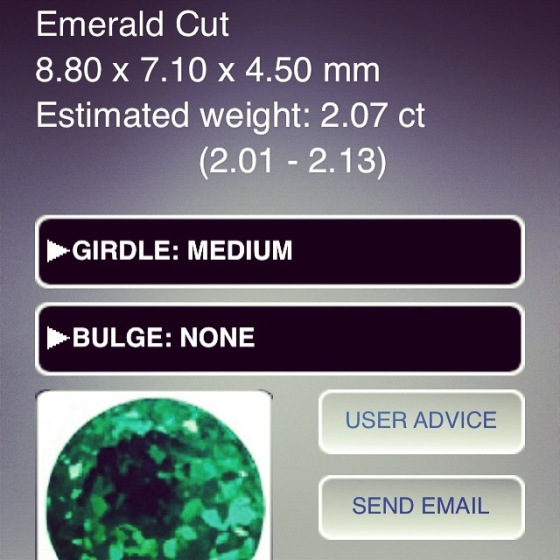Good afternoon my dear, I hope that you have had a lovely one so far. I find that a New Year always motivates me to sort things out and start afresh, and this January is no exception! Today for example I have been transferring a lot of jewellery photos onto an external hard drive, to hopefully free up a bit of space on my laptop – and I kept running into all these interesting pictures of emeralds, that I wanted to share with you:

Emerald and Diamond ring from Richard Ogden, in the Burlington Arcade
The ring above features an emerald and two diamonds and it landed in my hands at work, as the stone weight needed to be measured. Now I have learnt to calculate the weight of a gemstone the old school way too, but in this case I played around with an amazing app on my phone, where the following result came up:
As per usual I was a few digits away from my boss’ result, but not too far, so I was quite pleased! Often when you buy an antique or vintage diamond ring, the diamond hasn’t been taken out of its setting to be measured and certificated, as it could damage the beautiful old settings, so the antique dealers have to be very good at calculating weights etc from difficult angles. I always find it such fun to try to master a diamond gauge – they look like this (top right corner of the photo):
And emeralds are just such divine little gemstones! Sometimes people come by to look at an emerald ring for an engagement ring, but I tend to advise them to either choose a diamond, a sapphire or a ruby – only because emeralds are not the hardest stones around…

Emerald and Diamond Ring Art Deco style from Moira Fine Jewels
… and the last thing you want to do when you wear your engagement ring every day, is having to worry about cracking or denting it, so a more robust gemstone is usually a better idea. However – I know one lady who has worn an aquamarine, which is an ever softer stone than an emerald, as her engagement ring for thirty years, and it is in perfect shape! So it obviously also comes down to what kind of a person you are – I for one could never wear anything even remotely fragile, as I would damage it in no time. Unfortunately!
And here is another lovely emerald and diamond ring – this one is from Moira Fine Jewels and you can pop by Richard Ogden in the Burlington Arcade to view it closer, if it takes your fancy.









